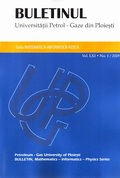1.
 | Time-Frequency Analysis of Gelfand- Shilov-Roumieu
Mihai Pascu | pg. 1-8 |
| | The present paper aims at realizing a thorough time-frequency analysis of some spaces of rapidly decreasing functions and of ultradistribution spaces. We extend the inversion formula for short time Fourier transform to the general spaces of GSR ultradistributions. |
2.
 | Effects of Human and External Factors on Traffic Accidents
Murat Sari, Ozcan Mutlu, Asuman Zeytinoglu | pg. 9-18 |
| | This work is to investigate traffic accidents in Denizli, in Turkey, to analyze accidents with regard to their causes, human and external factors. To this end, data reported by police were used. The results revealed that human and external factors are significantly effective on the accidents. The analysis showed that the age is an effective parameter on the rate of accident. |
3.
 | Sur les Multifonctions Floues δ-continues
Mihai Brescan | pg. 19-24 |
| | Le but de notre travail est de généraliser pour une multifonction floue la notion de δ-continuité, étudiée dans la topologie générale par Y. Kuçuc, T. Noiri et V. Popa. Le travail contient quelques théorèmes de caractérisation pour cette classe de multifonctions. |
4.
 | The Convergence Theorem for Discrete-time Martingales
Georgeta Maniu | pg. 25-30 |
| | This paper gives an insight to the mathematical theory of the discrete-time martingale, including basic definitions and results. Still, the paper is focused on prooving a variant of the Convergence Theorem based on Doob’s Inequality for martingales. The second part of this paper presents a proof of The Law of Large Numbers for discrete-times martingales, as an application of the Convergence Theorem. |
5.
 | The Method of the Weakly Conjugate Operator: Extensions and Applications to Operators on Graphs and Groups
Marius Mantoiu, Serge Richard, Rafael Tiedra de Aldecoa | pg. 31-42 |
| | In this review we present some recent extensions of the method of the weakly conjugate operator. We illustrate these developments through examples of operators on graphs and groups. |
6.
 | On the Points of Weak m-Continuity and Weak m-Discontinuity
Valeriu Popa, Takashi Noiri | pg. 43-50 |
| | In the present paper, we define the notion of weakly m-continuous functions at a point of the domain and obtain some characterizations of these functions. Furthermore, we characterize the set of all points at which the function is not weakly m-discontinuous.
|
7.
 | Advanced Traveler Information System: An Agent-based Approach for Itineraries Web-Services Composition
M.F. Feki, M.A. Kamoun, S. Hammadi | pg. 51-64 |
| | A wide and growing variety of transport s useful information systems and services are becoming available daily to assist travelers, but technical supports for discovering, selecting and integrating these resources are still limited. This is due to several reasons of different types: organizational, economic, juridical, technical and quality reasons. The purpose of this study was, essentially, to suggest an Agent-Based Cooperative Information System for Multi-modal transport s travelers, trying to make the existing information system cooperating efficiently to provide travelers with multi-modal and multi-operator information itinerary involving different means of transport and several operators. More precisely, this Agent-Based Cooperative Information System has essentially for its aim to calculate the shortest itinerary
in terms of distance, time, or cost, to assist travelers using a new approach of web services composition. |
8.
 | A Ridge Regression Model of the Cracking Process
Cristian Marinoiu | pg. 65-70 |
| | Although recent theoretical and practical developments have considerably widened the range of modelling instruments, linear regression models still claim a central place in statistical modelling. This fact is largely due to the remarkable characteristics of the least squares approach. However, when the matrix of regressing variables is ill-conditioned, the stability of regression coefficients is in turn affected, and the model thus configured is implicitly unrealistic. Under such circumstances, the ridge regression estimator may prove to be a viable alternative. The present paper deals with the setting up of a ridge regression model for the catalytic cracking of a chemical reactor. |
9.
 | Availability of Computational Resources for Desktop Grid Computing
Monica Vladoiu, Zoran Constantinescu, Catalina Negoita | pg. 71-76 |
| | The computing power of a single desktop computer is insufficient for running complex algorithms. A very convenient solution is based on the use of non-dedicated desktop PCs in a Desktop Grid Computing environment. Here, the costs are highly distributed: every volunteer supports her resources (hardware, power, internet connections) while the benefited entity provides management infrastructures (network bandwidth, servers, management services), receiving in exchange an enormous and otherwise unaffordable computing power. There has been little insight into the temporal structure of resource availability within an organizational setup. We present here our observations regarding the availability of computing resources to be used in a desktop grid. |
10.
 | A Decision Tree for Weather Prediction
Elia Georgiana Petre | pg. 77-82 |
| | A decision tree represents a decision support tool very often used because it is simple to understand and interpret. Classification and Regression Trees - CART - is a technique formed by a collection of rules based on values of certain variables in the modelling data set. This paper presents a small application of CART for whether prediction. It had been chosen the data collection registered over Hong Kong. The data was recorded between 2002 and 2005. To build the decision tree we used a free data mining software available under the GNU General Public License– Weka. Then, there are presented the decision tree, the results and the statistical information about the data used to generate the decision model. |
11.
 | LSL in Second Life
Liviu Ionita | pg. 83-86 |
| | Software agents are met not only in real life, but also in virtual reality. Software agents are met not only in real life, but also in virtual reality. Second Life environment enables its users to create/ design intelligent software agents (called avatars) that may interact. To these avatars, there may be attributed certain behaviours by means of an adequate Second Life language, called LSL (Linden Script Language). In this paper, the author describes Second Life virtual life environment and illustrates LSL’s use on a robot called RoLyv. |
12.
 | Mechanisms to Avoid the Premature Convergence of Genetic Algorithms
Elena Simona Nicoara | pg. 87-96 |
| | The optimization by genetic algorithms often comes along with premature convergence bias, especially in the multimodal problems. In the paper, we propose and test two mechanisms to avoid the premature convergence of genetic algorithms by preserving the population diversity in two different manners. These are the dynamic application of many genetic operators, based on the average progress, and the population partial reinitialization. The mechanisms were tested by implementing them in the NSGA_II algorithm, applied to one of the most difficult job shop scheduling test problems, ft10. The comparative
analysis between the new algorithm and the NSGA_II in the absence of the submitted mechanisms, alongside with an elitist and the canonic genetic algorithm, proves the usability of both proposed mechanisms. |
13.
 | Weather Forecast using SPSS Statistical Methods
Daniela Schiopu, Elia Georgiana Petre, Catalina Negoita | pg. 97-100 |
| | This paper presents a case study of using SPSS 13.0 in weather prediction. The data were collected from 2001 till 2005 and it was made a prediction of future temperatures encountered in this region. For this, we used two methods provided by SPSS 13.0, such as factor analysis and linear regression. |
14.
 | The Planck Law in Quantum Physics and Stochastic Physics
Ion Simaciu, Zoltan Borsos | pg. 101-108 |
| | In the present paper the compatibility of Einstein method to obtain de spectral energy density law (Planck’s Law) with the existence of the zero point field radiation is investigated. It is demonstrated that this compatibility exists only if we consider the interaction of half parts of photons, with the same
frequencies determined by the thermal radiation from the unit volume, with the cavity’s oscillators. The quantum physics is based on Planck and Einstein’s hypotheses (energy-momentum and action quantification) generalized by L. de Broglie for all particles and he develops a formalism that can be used to obtain material waves modes in a cavity defined by the potential energy space-time dependence. As a consequence, the quantum physics establish a virtual field of zero point quantum fluctuation (ZPF – Zero Point Field). The stochastic physics is based on the fundamental hypothesis that the quantum
properties of macroscopic systems are the consequences of classical interactions of these systems with a real electromagnetic field at T = 0 (CZPF – Classical Zero Point Field). |
15.
 | The Refractive Index of the Physical Vacuum Modified by a Stochastic Electromagnetic Field
Zoltan Borsos, Ion Simaciu | pg. 109-112 |
| | In this paper there are derived the components of the vacuum permittivity and permeability tensors induced by a background electromagnetic radiation field with random phase in order to establish a limit of stochastic. To achieve this goal we started with the tensors expressions of modified vacuum by an electromagnetic field derived by Euler and Kockel. These relations are customized for a field with continuous spectrum and random phases. The modified vacuum by that field is optically homogeneous and isotropic. The vacuum properties modified by the stochastic field at temperature T = 0K (CZPF
background) are just free vacuum properties (physical vacuum in a region of space without substance and fields) with εVjj = µVjj = 1. This assumption implies an upper limit of background spectrum. The limit frequency established is higher than the Compton frequency for electron.
|



